

Bioenergetics. Overview[edit] Bioenergetics is the part of biochemistry concerned with the energy involved in making and breaking of chemical bonds in the molecules found in biological organisms.
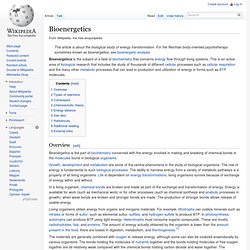
Growth, development and metabolism are some of the central phenomena in the study of biological organisms. The role of energy is fundamental to such biological processes. The ability to harness energy from a variety of metabolic pathways is a property of all living organisms. Life is dependent on energy transformations; living organisms survive because of exchange of energy within and without.
In a living organism, chemical bonds are broken and made as part of the exchange and transformation of energy. Living organisms obtain energy from organic and inorganic materials. The materials are generally combined with oxygen to release energy, although some can also be oxidized anaerobically by various organisms. Living organisms produce ATP from energy sources via oxidative phosphorylation. [edit] Cotransport[edit]
Biomagnification. Persistence – where the substance can't be broken down by environmental processesFood chain energetics – where the substance concentration increases progressively as it moves up a food chainLow or non-existent rate of internal degradation or excretion of the substance – often due to water-insolubility The following is an example showing how bio-magnification takes place in nature: An anchovy eats zoo-plankton that have tiny amounts of mercury that the zoo-plankton has picked up from the water throughout the anchovies lifespan.
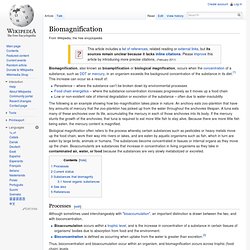
A tuna eats many of these anchovies over its life, accumulating the mercury in each of those anchovies into its body. If the mercury stunts the growth of the anchovies, that tuna is required to eat more little fish to stay alive. Because there are more little fish being eaten, the mercury content is magnified. Processes[edit] Although sometimes used interchangeably with "bioaccumulation", an important distinction is drawn between the two, and with bioconcentration.
DDT. DDT (dichlorodiphenyltrichloroethane) is a colorless, crystalline, tasteless and almost odorless organochloride known for its insecticidal properties.
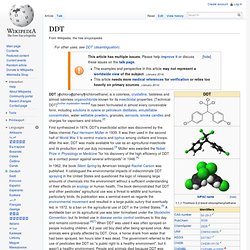
[Technical DDT][further explanation needed] has been formulated in almost every conceivable form, including solutions in xylene or petroleum distillates, emulsifiable concentrates, water-wettable powders, granules, aerosols, smoke candles and charges for vaporisers and lotions.[2] First synthesized in 1874, DDT's insecticidal action was discovered by the Swiss chemist Paul Hermann Müller in 1939. It was then used in the second half of World War II to control malaria and typhus among civilians and troops. After the war, DDT was made available for use as an agricultural insecticide and its production and use duly increased.[3] Müller was awarded the Nobel Prize in Physiology or Medicine "for his discovery of the high efficiency of DDT as a contact poison against several arthropods" in 1948.[4] Properties and chemistry[edit] History[edit]
Bioaccumulation & Biomagnification. Based on Mader, Sylvia S. 1996.

Biology - 5th Ed. WCB and Cox, G.W. 1997. Conservation Biology - 2nd ed. WCB In this section, we will examine how pollutants move through the various trophic levels in an ecosystem. There are two basic terms we are discussing here. Bioaccumulation: increase in concentration of a pollutant from the environment to the first organism in a food chain Biomagnification: increase in concentration of a pollutant from one link in a food chain to another We are concerned about these phenomena because together they mean that even small concentrations of chemicals in the environment can find their way into organisms in high enough dosages to cause problems.
Long-lived mobile soluble in fats biologically active If a pollutant is short-lived, it will be broken down before it can become dangerous. Classic example: DDT DDT stands for dichloro, diphenyl trichloroethane. This means that after 100 years, there will still be over a pound of DDT in the environment. Biomagnification.
The figure shows how DDT becomes concentrated in the tissues of organisms representing four successive trophic levels in a food chain.
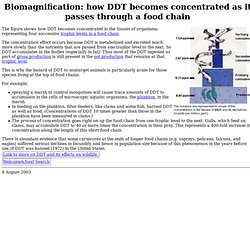
The concentration effect occurs because DDT is metabolized and excreted much more slowly than the nutrients that are passed from one trophic level to the next. Biomagnification Definition Page. Notice: This page is no longer being maintained, and will be phased out.
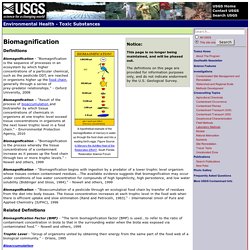
The definitions on this page are provided for information purposes only, and do not indicate endorment by the U.S.